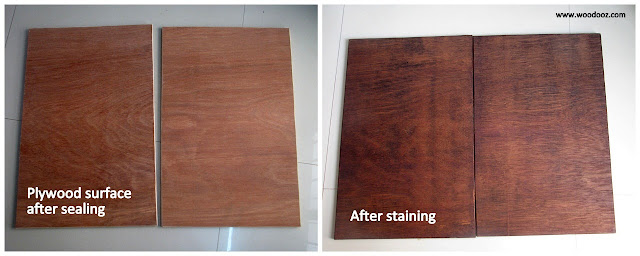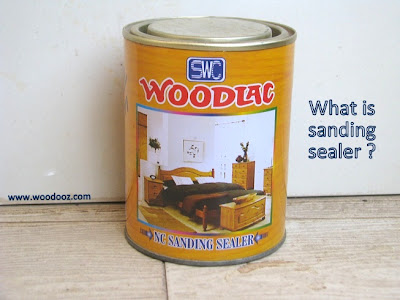Category :
how to stain wood
Sunday, August 04, 2013
Over the last few months, we have been looking at the various preparatory steps involved in applying stain to wood. Today, we come to the conclusion of this series as we look at how to apply stain. While I have been mentioning this in most of my earlier posts, I would like to reiterate that stains help augment the grain patterns and give them a more enhanced look. If you landed here directly, do consider checking
all the other posts in the staining series.
Complete guide to wood staining
|
 |
| How to apply stain |
The application of stain is much like how we applied sealant in the last tutorial. The following are the materials required :
- A bottle of stain (Asian paints / MRF / Wudfin / Sheenlac )
- Gada Cloth
- Thinner (If you need the color to be lighter)
Application procedure
- Pour the stain into a bowl
- Mix thinner only if you want the shade to be lighter
- Dip the gada cloth in the bowl of stain
- Dab it to squeeze the excess stain
- Apply the stain along the grains covering a small area
- Allow a minute or two for the stain to be absorbed by the wooden surface
- Before the stain is dry, wipe of the excess stain off the surface (using a dry piece of gada cloth)
 |
| How to apply wood stain |
- Repeat the procedure until you have covered the entire surface area of the wood
- Give it about 30 minutes drying time before you apply the subsequent coats
- Apply multiple coats as desired
- Remember to apply varnish or other top coats for long term durability
And that is about it. Just one thing though. Much like any other activity, achieving perfection in staining takes lot of patience and practice. You may probably not get it the first time. But it is not rocket science and with little repeat effort, you will be happy with what you can do to your small furniture and other craft projects.
Follow these steps and let me know how you fared in staining. If you think I missed something or something can be done in a better way, leave me your comments.
Monday, June 17, 2013
The sanded surface of the wood looks very smooth. But in reality, if you inspect closely, the wooden surface will have minute pores and jagged valleys. Application of stain directly on top of the sanded surface may, and I repeat, may result in uneven absorption of the stain.
While the color is taken in well by most portion of the wooden surface, some portions may look patchy because of poor absorption of the applied stain.
Complete guide to wood staining
|
 |
| Sanding Sealer |
Other posts in the staining wood series
Secondly, while sanding results in desired smoothness, it does not necessarily make the surface completely flat, and this you would notice when you run your palm / fingers along the sanded surface.
Sanding sealers help in overcoming the above two issues. Here's what sealers do when applied on a wooden surface:
- They fill the pores along the wooden surface and make it smooth to the touch
- The allow for consistent absorption of stain coat preventing patchiness
- They also bring out the splendor of the grain pattern when stain is applied
- Each layer of sealer can be sanded with fine grit sand paper (hence the name sanding sealer) adding increasing levels of evenness to the surface
There is also an opinion that sealers should actually go on top of the stain and is not an equivalent of pre-stain conditioners. However, in my personal experience,
since sealers are used with thinners, I have seen the thinner removing the stained color from off the surface. Most carpenters I have had a word with state that they actually mix the stain and sealer and apply it in one go. I have not tried it and hence not able to comment on it.
For now, we have already seen how sanding is a mandatory surface preparation step in the staining process.
The next post is all about sealers and how they can be applied on wooden surface. Have you stained furniture before? Did you have to work with sealers? Leave me a comment and share your experience.
Tuesday, February 19, 2013
In one of the previous posts, we did look at
an introduction to wood stains, the different brands available, cost and the basic application procedures. From this post on, we will look at, in detail, how to approach applying wood stains to your wooden substrate. We will delve into the various materials and supplies required, surface preparation techniques, the actual application procedure of stain and the top coat.
Complete guide to wood staining
|
For the purpose of demonstration, I will use a spare sheet of One Side Teak. I will use both sides of the sheet to lay bare how stains work and enhance the look of the substrate.
 |
| How to stain wood - A beginner's guide |
The following are the topics that I will discuss in detail in the forthcoming posts. Each of these steps is important and critical to the effectiveness of the staining process.
- Step 1 : Sanding the wooden surface
- Step 2 : Understanding sealers and why they are required
- Step 3 : Applying Sealer as a pre-conditioner
- Step 4 : Applying the wood stain
- Step 5 : Applying a top coat (Varnish)
Materials / Supplies required
- Sand papers (Grit 80, 100, 120, 150, 220)
- Muslin cloth (Ask for Gada Thuni if you are in Chennai) 1 meter
- Thinner 500ml
- Sanding Sealer 500 ml
- Wood stain 100ml
- Rag Cloth
- Wood Polish
The details of the brands, cost etc… , I shall discuss in the individual posts.
 |
| Materials required for staining wood |
Some safety precautions
- Using a mask is mandatory. Sanding can send in dust particles and staining can send strong fumes through your nostrils.
- Cover your eyes to protect from the dust irritating your eyes.
- Use gloves because it is very difficult to remove stain off your fingers.
- Work in an open, well ventilated space
That said, shall come back and take you through each of these individual steps in the coming days / weeks. Meanwhile, do remember to leave a comment and enter your e-mail address below just so you do not miss the rest of the posts in this series.
- Somu












